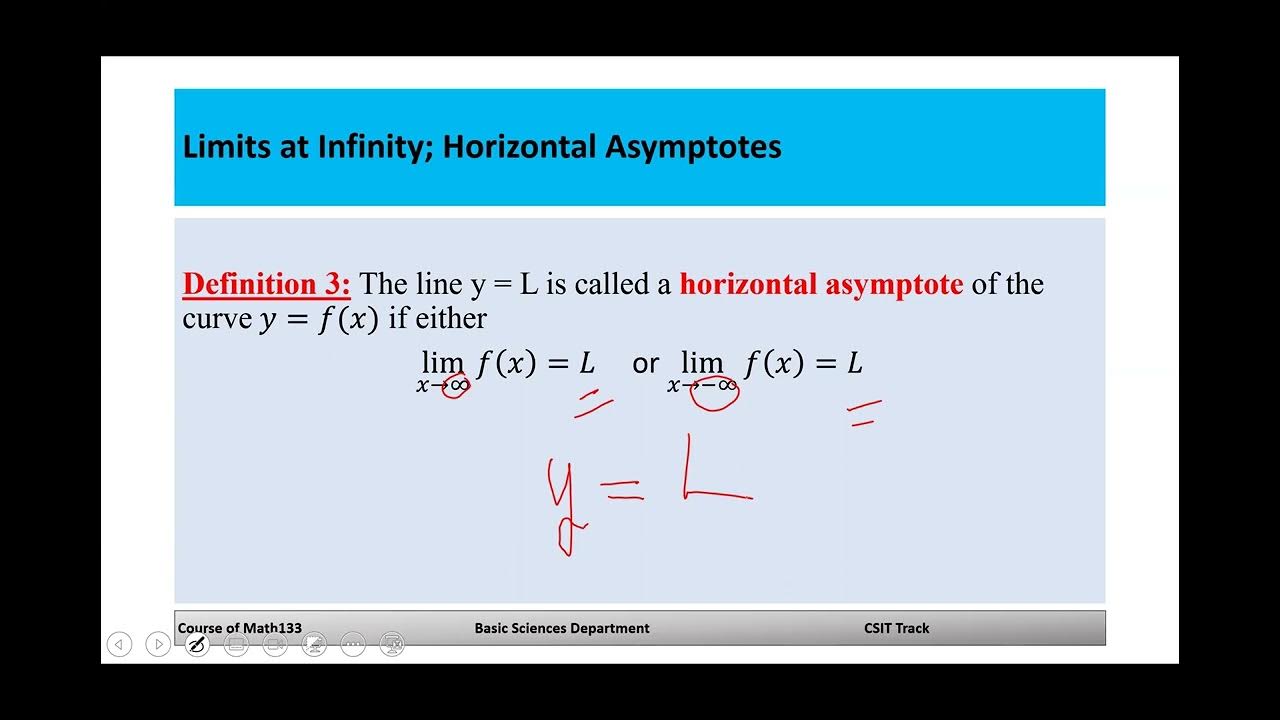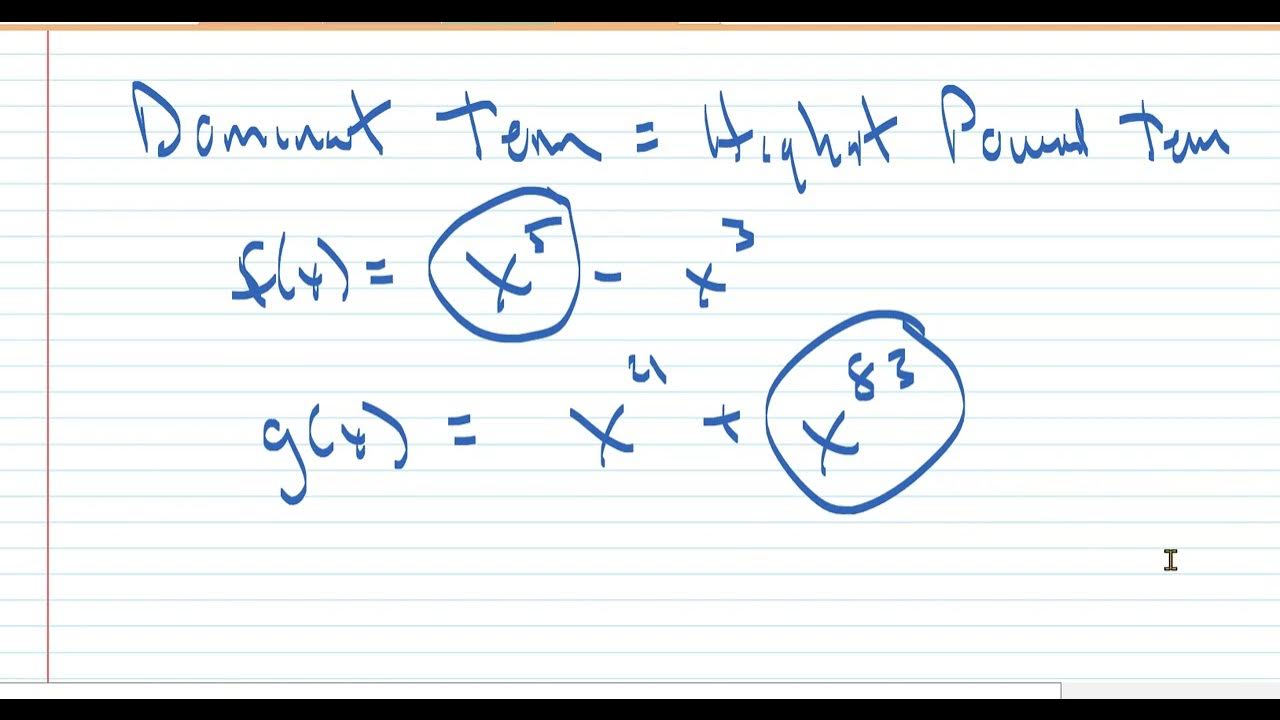How To Find The Limit At Infinity
TLDRThis lesson delves into the concept of limits at infinity for various functions. It explains how to determine the limit as x approaches positive or negative infinity for functions like x squared, x cubed, and polynomials. The script also covers rational functions, discussing how to simplify them to find the limit and emphasizing that bottom-heavy functions approach zero while top-heavy functions approach infinity. Examples are provided to illustrate the process, including the method of dividing by higher powers of x to simplify and find the limit.
Takeaways
- 🌟 The limit of a function as x approaches infinity can be determined by considering what happens to the function as x becomes very large.
- 📈 For functions like x squared or x cubed, as x approaches infinity, the function also approaches infinity, either positive or negative depending on the sign of x.
- 🔢 When dealing with polynomial functions, insignificant terms can be ignored when evaluating limits at infinity, focusing on the term with the highest degree.
- 👉 For example, the limit of 5 plus 2x minus x cubed as x approaches negative infinity simplifies to the limit of negative x cubed, which is negative infinity.
- 🤔 When evaluating limits of rational functions, if the degree of the numerator is less than the degree of the denominator, the limit as x approaches infinity is zero.
- 📊 To find the limit of a rational function with the same degree in the numerator and denominator, divide the coefficients of the leading terms to find the limit.
- 🛑 If a rational function is top heavy (numerator degree greater than denominator degree), the limit as x approaches infinity is the leading coefficient of the numerator times infinity.
- 📈 For bottom-heavy rational functions, the limit can be found by multiplying the numerator and denominator by a power of x that makes the denominator approach zero, simplifying the expression.
- 📚 When the highest degree terms in the numerator and denominator cancel each other out, the limit is the ratio of the remaining coefficients.
- 🔍 To illustrate the process, the limit of 5x minus 7x cubed over 2x squared plus 14x cubed minus 9 as x approaches negative infinity is negative one half.
Q & A
What happens to the function x squared as x approaches infinity?
-As x approaches infinity, the function x squared also approaches infinity, because squaring a large number results in an even larger number.
What is the limit of x squared as x approaches negative infinity?
-The limit of x squared as x approaches negative infinity is also positive infinity, because squaring a negative number results in a positive value, and the principle is the same as for positive infinity.
How does the limit change for the function x cubed when x approaches infinity?
-For positive x cubed, the limit as x approaches infinity is positive infinity, as cubing a large number results in an even larger positive number. However, for negative x cubed, the limit is negative infinity due to the odd power.
What is the limit of the expression 5 plus 2x minus x cubed as x approaches negative infinity?
-The limit of the expression 5 plus 2x minus x cubed as x approaches negative infinity is positive infinity. The terms 5 and 2x are insignificant compared to the negative x cubed, which dominates the expression as x becomes very large.
How does the limit of a rational function with a higher degree in the numerator compare to the limit of a function with a higher degree in the denominator?
-A rational function with a higher degree in the numerator (top heavy) will have a limit of infinity as x approaches infinity, whereas a function with a higher degree in the denominator (bottom heavy) will have a limit of zero.
What is the limit of one over x as x approaches infinity?
-The limit of one over x as x approaches infinity is zero. As the denominator (x) becomes larger, the value of the fraction becomes smaller, approaching zero.
How can you find the limit of a rational function with the same degree in the numerator and denominator as x approaches infinity?
-You can find the limit by dividing the coefficients of the highest degree terms in the numerator and denominator. The limit will be the ratio of these two coefficients.
What is the limit of the expression 5x minus 7x cubed over 2x squared plus 14x cubed minus 9 as x approaches negative infinity?
-The limit of this expression as x approaches negative infinity is negative one half (-1/2). This is found by multiplying the numerator and denominator by one over x cubed and simplifying the expression.
How do you simplify a rational function to find its limit at infinity?
-To simplify a rational function for the limit at infinity, you can eliminate insignificant terms and focus on the terms with the highest degree. For the limit at negative infinity, you can also multiply the numerator and denominator by a power of x that matches the highest degree term to simplify the expression.
What is the limit of the function 5x plus 6x squared divided by 3x minus 8 as x approaches infinity?
-The limit of this function as x approaches infinity is positive infinity. The significant term in the numerator is 6x squared, which is more influential than 5x, and the significant term in the denominator is 3x, resulting in a ratio of 2x as x approaches infinity.
What happens to the limit of a rational function when the degree of the numerator is greater than the degree of the denominator?
-When the degree of the numerator is greater than the degree of the denominator, the limit of the rational function as x approaches infinity is infinity. Conversely, if the degree of the denominator is greater, the limit is zero.
Outlines
🌌 Understanding Limits at Infinity
This paragraph introduces the concept of limits at infinity, specifically focusing on how to determine the limit of a function as x approaches positive or negative infinity. It explains the behavior of simple functions like x squared and x cubed as x becomes very large or very small, and how to handle polynomial and rational functions with different degrees in the numerator and denominator. The key takeaway is that the limit of a function at infinity depends on the highest degree term and whether the function is 'bottom heavy' (denominator has a higher degree) or 'top heavy' (numerator has a higher degree).
📚 Calculating Limits of Rational Functions
This section delves into the specifics of calculating limits for rational functions at infinity. It explains the process of simplifying expressions by focusing on the most significant terms and ignoring the insignificant ones. The paragraph provides a method for handling functions with the same degree in the numerator and denominator by dividing coefficients and for those with different degrees by multiplying the numerator and denominator by a power of x that matches the highest degree term. The summary emphasizes the importance of recognizing the degree of the terms and the behavior of the function as x approaches infinity or negative infinity.
🚀 Applying the Concepts to Complex Examples
The final paragraph applies the concepts learned to more complex examples of rational functions, demonstrating how to simplify expressions and determine the limit at infinity. It shows how to handle both 'bottom heavy' and 'top heavy' functions, providing a step-by-step approach to simplify the expressions and calculate the limits. The paragraph reinforces the idea that the limit behavior is determined by the most significant terms and the overall degree of the function, leading to conclusions of positive or negative infinity based on the function's structure.
Mindmap
Keywords
💡Limit at Infinity
💡Polynomial Function
💡Rational Function
💡Bottom Heavy
💡Top Heavy
💡Insignificant Terms
💡Leading Coefficients
💡Negative Infinity
💡Simplifying Expressions
💡Dominant Terms
Highlights
The limit of a function as x approaches infinity can be determined by understanding how the function behaves with very large values of x.
For the function x squared, as x approaches infinity, the value also approaches infinity, indicating that the limit is positive infinity.
Similarly, the limit of x squared as x approaches negative infinity is also positive infinity, since squaring a negative number results in a positive value.
For the function x cubed, the sign of the limit depends on whether x is approaching from the positive or negative side, resulting in positive or negative infinity, respectively.
When dealing with polynomial functions, insignificant terms can be ignored when determining limits at infinity, focusing on the term with the highest degree.
The limit of an expression like 5 plus 2x minus x cubed as x approaches negative infinity simplifies to negative infinity, as the dominant term is negative x cubed.
For rational functions, when the degree of the denominator exceeds the degree of the numerator, the limit as x approaches infinity is zero.
An example of a rational function limit is one over x, which approaches zero as x approaches infinity because the denominator grows without bound.
To find the limit of a rational function with a bottom-heavy numerator and denominator, you can multiply the top and bottom by a power of x that corresponds to the degree of the denominator.
When the degrees of the numerator and denominator are the same, the limit can be found by dividing the coefficients of the highest degree terms.
For a rational function with a top-heavy numerator and denominator, you can simplify the expression by removing insignificant terms and focusing on the most significant terms.
The limit of a function with a top-heavy rational expression as x approaches infinity is determined by the most significant term in the numerator divided by the most significant term in the denominator.
In the case of a rational function with the same degree in the numerator and denominator, multiplying the numerator and denominator by a suitable power of x can help in simplifying the expression to find the limit.
When the numerator is heavier than the denominator in a rational function, the limit as x approaches infinity is positive infinity.
For rational functions with the same degree in the numerator and denominator, the limit can be found by simplifying the expression and considering the highest degree terms.
The limit of a rational function can also be found by evaluating the expression with a very large value of x to see the behavior of the function.
Understanding the behavior of polynomial and rational functions at infinity is crucial for analyzing their limits and can be done by focusing on the highest degree terms.
Transcripts
Browse More Related Video

Business Calculus - Math 1329 - Section 1.5 (and 1.6) - Limits and Continuity

Math 133 Lecture 2 6

Calculus: Limits at Infinity-Algebraic

Finding limits at infinity using squeeze theorem | Squeeze or Sandwich Theorem - Calculus

Calculus:Limits of Rational Functions

Introduction to infinite limits | Limits and continuity | AP Calculus AB | Khan Academy
5.0 / 5 (0 votes)
Thanks for rating: